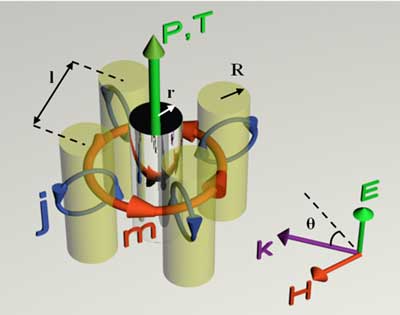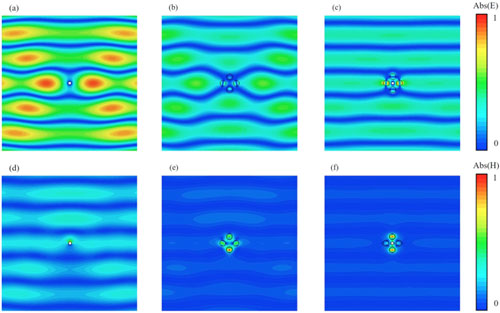| Aug 28, 2018 | |
Researchers develop a method for cloaking nano-sensors for optics and biomedicine(Nanowerk News) An international research group of scientists from Politecnico di Torino (Italy) and NUST MISIS (Russia) has developed a model of a new metamaterial, which will improve the accuracy of nano-sensors in optics and biomedicine by cloaking them from external radiation. |
|
| The article reporting the results has been recently published in Scientific Reports ("Multipolar passive cloaking by nonradiating anapole excitation"). | |
| The development of a new cloaking metamaterial for nano-sensors is carried out within the framework of the Italian-Russian project ANASTASIA (Advanced Non-radiating Scattering Tenuously Architectures And Sustaining Invisible Anapoles). | |
 |
|
| Figure 1: Visualization of a metamolecule, consisting of a PEC cylinder and four dielectric cylinders around. P stands for electric dipole moment of the conductor and T stands for toroidal moment of the dielectric coating | |
| The aim of the project is to model and then prototype a metamaterial, which will make nano-scale objects invisible in the uncovered THz frequency range. | |
| On the part of Politecnico di Torino, Professor Ladislau Matekovits heads the research group, while Professor Alexey Basharin leads the Russian team. In the research, 4 PhD students and other young professionals are also involved. | |
| A cylinder of perfect electric conductor (PEC) with radius r=2.5 µm has been considered in order to imitate a nano-sensor. Being metallic, it possesses very high wave scattering, allowing to carry out calculations for the maximum possible level of re-radiation. The modeling was performed in THz range, which stands between infrared and microwave bands. | |
| The key element of the new metamaterial is a metamolecule (Fig. 1), consisting of four dielectric lithium tantalate (LiTaO3) cylinders, r=5 µm. Serving as a coating for a nano-sensor, dielectrics interact with radiation, exciting non-radiating anapole mode. Separated from each other, all the elements radiate and distort the electric and magnetic fields (Fig. 2 a, b), but when considered all together the object becomes invisible for an external observer (Fig. 2 c). | |
 |
|
| Figure 2: Visible radiation of elements, where (a) is the central element without coating; (b) is coating elements without a central element; © is metamolecule: central element in the coating. | |
| Apart from the used LiTaO3, depending on the field of application, other materials can be considered. For example, in nano-optics it would be possible to work with silicon and germanium, while in biomedical sensoring biocompatible sodium chloride would be a possible alternative. | |
| The next research stage, which is the experimental characterization of a prototype of the proposed structure in vitro, is scheduled for this autumn. | |
| Concurrently, interests in creating configurations by using proper materials, e.g., graphene, and geometrical arrangements that are only transparent at certain wavelengths and/or angles of incidence are targeted. The challenge set by scientists from Politecnico di Torino and NUST MISIS is to generalize the experience to develop a theory which can be used to model and then assemble metamaterials that will cloak nano-scaled objects at all the wavelengths and at any angles. |
| Source: National University of Science and Technology MISIS | |
|
Subscribe to a free copy of one of our daily Nanowerk Newsletter Email Digests with a compilation of all of the day's news. |
